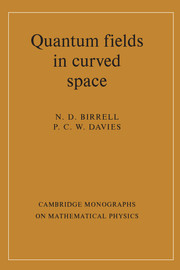Book contents
- Frontmatter
- Contents
- Preface
- Preface to the paperback edition
- Conventions and abbreviations
- 1 Introduction
- 2 Quantum field theory in Minkowski space
- 3 Quantum field theory in curved spacetime
- 4 Flat spacetime examples
- 5 Curved spacetime examples
- 6 Stress-tensor renormalization
- 7 Applications of renormalization techniques
- 8 Quantum black holes
- 9 Interacting fields
- References
- Index
7 - Applications of renormalization techniques
Published online by Cambridge University Press: 05 August 2012
- Frontmatter
- Contents
- Preface
- Preface to the paperback edition
- Conventions and abbreviations
- 1 Introduction
- 2 Quantum field theory in Minkowski space
- 3 Quantum field theory in curved spacetime
- 4 Flat spacetime examples
- 5 Curved spacetime examples
- 6 Stress-tensor renormalization
- 7 Applications of renormalization techniques
- 8 Quantum black holes
- 9 Interacting fields
- References
- Index
Summary
This short chapter presents some explicit examples of the theory of regularization and renormalization discussed in chapter 6. The number of spacetimes for which one may compute 〈Tµν〉 in terms of simple functions is extremely limited, and we think it probable that all such cases have been included either here, in chapter 6, or in our references.
Special importance is attached to the Robertson–Walker models, both because of their cosmological significance, and also because, being conformally flat, they provide a good illustration of conformal anomalies at work. However, precisely because of their simplicity, these models do not display the full non-local structure of the stress-tensor, and in §7.3 we turn briefly to the less elegant but more realistic example of an anisotropic, homogeneous cosmological model.
Although the primary subject of this book is the theory of quantum fields propagating in a prescribed background spacetime, the motivation for much of this work rests with its possible application to cosmological and astrophysical situations, where the gravitational dynamics must be taken into account. Many cosmologists, for example, believe that the back-reaction of quantum effects induced by the background gravitational field could have a profound effect on the dynamical evolution of the early universe, such as bringing about isotropization. We do not dwell in detail on this important extension of the theory, but note that the results presented here constitute the starting point for such investigations. A short discussion of the wider cosmological implications is given in §7.4.
- Type
- Chapter
- Information
- Quantum Fields in Curved Space , pp. 225 - 248Publisher: Cambridge University PressPrint publication year: 1982



